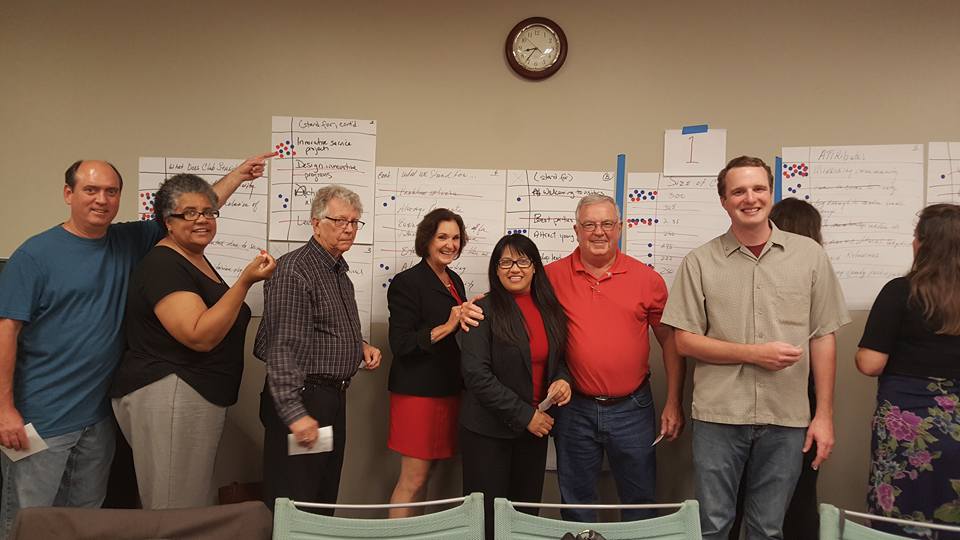Welcome

YOUR CLUB! - YOUR VISION!
A SERVICE TO CLUBS PROVIDED BY A TRAINED TEAM OF DISTRICT ROTARIANS
A strong and effective Rotary Club is vital to retaining and attracting quality members.
Club Visioning is about strategic planning for Rotary Clubs – something few Clubs do effectively. Visioning allows the club members to dream about what their club could become. From this dream comes a new sense of identity and a renewed commitment to make a club better than it is today.
The Rotary International Club Leadership Plan recommends every Club develop a long-range strategic plan. It’s about continuity and consistency of leadership and programming. A strategic plan sets the stage for future progress.
A Club Visioning Session helps a Rotary club design its OWN vision and then set up the necessary steps to achieve that vision. The result is not a vision decided by the Rotary District or by Rotary International. It is a vision designed and endorsed by a Club’s own members.
Club Visioning is not just another membership program. It addresses all aspects of the life of a Rotary Club. It is not a program just for struggling Rotary Clubs. It is a program that can benefit any Club.
The History:
In April of 2015 sixteen District 5650 Rotarians attended a one-day facilitator training session conducted by International Vision Facilitation Council trainers, Joe Kovarik and Michael Ericksen, in Omaha, Nebraska. Since then they’ve trained eighteen of the thirty nine clubs in our district.
The Opportunity:
To bring together a cross-section of the club’s members, including leaders, potential leaders and brand new members who can work to begin building a consensus on their club’s vision for the next five years. The experience involves dialogue in a relaxed and friendly environment that has the proven ability to bring out new ideas and provide a “grounding” and understanding of the history and culture of the club.
The Framework:
By starting with the end in mind – a collective vision of the club in three years – the visioning process lays the groundwork to plan for a future that creates:
- Continuity of leadership, vision, and process
- Consistency in programming, projects, and activities
- Consensus and solidarity in purpose and action.
The Process:
The club president (or his/her designee) contacts the District Visioning Coordinator Rob Simmon to discuss the process, learn the club’s responsibilities and schedule a session. Rob will put together a four- to six-member District 5650 Visioning Facilitation Team. A session is scheduled and the club handles all of the meeting arrangements including location, food (usually a box dinner), invitations to members and other relevant requirements.
The Visioning Session:
First and foremost, all of those participating are asked to suspend their beliefs and open themselves up to dream. Then through the simple act of writing down goals in a group setting and sharing them with others, camaraderie is built, agreement on a vision is fostered, and club members establish preliminary benchmarks. This renewed focus on objectives, which is completed in a dedicated, four-hour work session (typically 5:00–9:00 p.m.), moves the club toward their desired actions and outcomes. The information developed in the session creates the framework for discussions with the rest of the club, usually through a club assembly. The initial visioning process works best with a group of between 10 and 20 members. The Visioning Team limits the group size to 20 so that attendees all have a full opportunity to participate.

The Challenge and the Outcomes:
To gather many ideas and opportunities for the future and condense them down to the most desirable goals determined through consensus, all within a very limited time frame. At the end of the meeting (usually in the early evening), the club members have a clear vision of:
- What the club stands for in the community
- The club’s target membership size in five years
- A clear understanding of the club’s attributes
- Top three objectives in each of Rotary’s Four Strategic Priorities
- Areas of mutual agreement on fund-raising, public image and involvement in The Rotary Foundation or the club’s own foundation.
- A plan to move forward by:
- Bringing the rest of the members into the discussion;
- Settling on a club vision or “elevator speech”; and
- Setting short and long-term goals.
Rob Simmon
District Visioning Coordinator
Clubs that have participated in Visioning
|
CB Centennial
|
May 2015
|
|
Omaha Downtown
|
Jun 2015
|
|
Auburn
|
Aug 2015
|
|
Omaha North
|
Oct 2015
|
|
Omaha Suburban
|
Sep 2015
|
|
CB Noon
|
Jan 2016
|
|
Glenwood
|
Feb 2016
|
|
SW Omaha
|
Mar 2016
|
|
Omaha West
|
Jun 2016
|
|
Wayne
|
Aug 2016
|
|
Omaha Millard
|
Nov 2016
|
|
Norfolk
|
Feb 2017
|
|
Avoca
|
Feb 2017
|
|
Omaha Northwest
|
Mar 2017
|
| Lincoln #14 | Jun 2017 |
| Shenandoah | Jun 2018 |
| Beatrice | Oct 2018 |
| Red Oak | Nov 2022 |
| Omaha Suburban | Jan 2023 |
| Omaha West | Mar 2023 |
| Wayne | Jun 2023 |
|
Omaha Downtown
|
Jan 2024 |